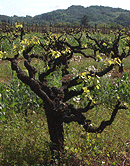|
Wineries
Wines
More Info. |

The
Basics of Tasting Wines Some people have the
impression that wine tasting is a ritual that can
only be performed by experts. The fact is that
tasting can be done without any special knowledge
of wines. Keep in mind that a winery offers wines
for tasting so that one can become familiar with
the wines, and hopefully enjoy them. The goal of
the taster is to discover wines he/she will enjoy.
Therefore, wine tasting is most always a relaxing,
enjoyable experience. The order of tasting wines is
important and is usually arranged by the wine host.
The normal order of tasting is dry whites to medium
whites, light reds to full-bodied reds, sweet
whites followed by dessert and fortified wines. It
is common to rinse the residual wine from your
tasting glass between wines or between types of
wine (whites, reds, etc.) and many wine hosts
provide bland crackers or pretzels which you can
use to "clear" your palate between
tastes. There are three basic
components to evaluating wines: appearance, smell
and taste. Appearance.
Start by holding the glass (containing the wine, of
course) toward a white background and away from you
at an angle. An experienced wine taster will look
for three characteristics: color,
depth
and clarity.
In red wines, a brilliant red color usually
indicates a wine in it's prime, a purplish hue may
indicate a very young wine and a brown hue may
indicate that a wine is past it's prime or
oxidized. A dry white wine should have a pale straw
color while an aged dry wine or a sweet or desert
wine should have a yellow-gold hue. The depth of
color usually suggests the quality of the grapes
and how full-bodied the wine will be. The wine
should be completely clear and cloudless, although
some older reds may have some harmless
sediment. Smell.
Next, gently swirl the wine in a way that the wine
coats the inside of the glass (without spilling on
yourself or your neighbor). The swirling motion
intensifies the wines aroma
(the fruity smell) and bouquet
(the fragrance developed through aging), while the
shape of the glass concentrates the aroma within
the confined space. Put your nose over the glass
and gently inhale. The wine's aroma is a good
indicator of the quality and characteristics (such
as fruity or flowery) of the wine. Taste.
The taste of the wine should confirm its aroma and
bouquet. An experienced wine taster may inhale
(slurp) some air while sipping to aerate the wine
and bring out the wine's more complex flavors. Let
the wine stand in your mouth for a moment. The
texture
and weight of the wine is described as it's
body.
A full-bodied wine will feel rich and heavy in your
mouth, while a thin wine will feel somewhat watery.
Generally, wines with less alcohol are
light-bodies, while those with higher alcohol are
medium to full-bodied. Upon swallowing the wine,
notice the finish:
the lasting flavors and impression that the wine
leaves on your palate. A long, flavorful finish is
a sign of a quality wine. There are hundreds of
adjectives that can describe the essence of a wine.
A wine's fruit component (aroma and flavor) may be
of tropical fruit (melon, pineapple), berries
(blackberry, black currant), dried fruit (fig,
strawberry jam) or tree fruit (apple, peach). Often
a wine will have other characteristics described as
nutty (almond, hazelnut), spicy (black pepper,
currant), vegetative (green pepper, cut grass),
floral (violet, orange blossom) or caramelized
(chocolate, butterscotch). In general, a young
white wine should taste fresh, fruity and crisp,
while red wines will have more complex berry and
woody flavors. If you are recording your
impressions, use descriptions that have meaning to
you&emdash;not the "experts." There are certain properties
that can only be evaluated by sense of taste: the
amount of sweetness (usually associated with white
wines or late harvest reds) as well as acidic or
bitter qualities. Tannins,
the astringent, puckery sensation usually found in
red wines is a primary factor in determining a
wine's aging potential and will soften with age.
Although wine is alcoholic, an alcohol taste should
not be noticeable in a quality wine. The way in
which each of these individual wine elements
interacts with each other is called the
balance.
A well-balanced wine will have a harmonious
combination of fruit, acid, sugar (in white wines),
tannin and alcohol, of which none will overpower
another. Finally, a wine of perfect
balance and style that combines multiple aroma and
flavor elements in a harmonious relationship is
considered complex.
Complexity is the quality that most winemakers
strive for and separates a great wine from a very
good one. Next in this
series: Storing
Wines |
